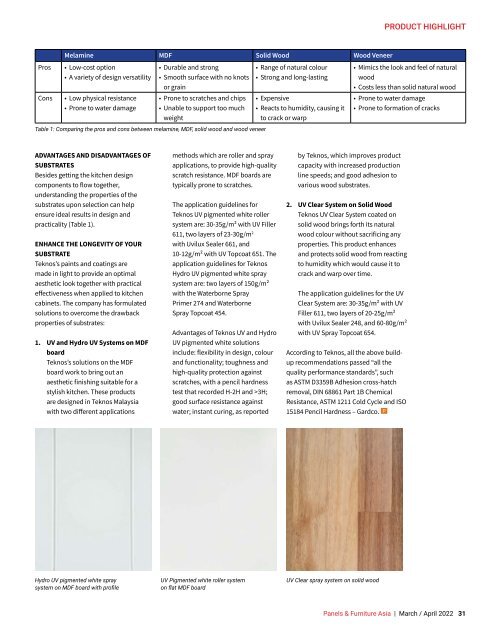Panels & Furniture March/April 2022
Panels & Furniture Asia (PFA) is a leading regional trade magazine dedicated to the woodbased panel, furniture and flooring processing industry. Published bi-monthly since 2000, PFA delivers authentic journalism to cover the latest news, technology, machinery, projects, products and trade events throughout the sector. With a hardcopy and digital readership comprising manufacturers, designers and specifiers, among others, PFA is the platform of choice for connecting brands across the global woodworking landscape.
Panels & Furniture Asia (PFA) is a leading regional trade magazine dedicated to the woodbased panel, furniture and flooring processing industry. Published bi-monthly since 2000, PFA delivers authentic journalism to cover the latest news, technology, machinery, projects, products and trade events throughout the sector. With a hardcopy and digital readership comprising manufacturers, designers and specifiers, among others, PFA is the platform of choice for connecting brands across the global woodworking landscape.
Create successful ePaper yourself
Turn your PDF publications into a flip-book with our unique Google optimized e-Paper software.
PRODUCT HIGHLIGHT<br />
Pros<br />
Cons<br />
Melamine MDF Solid Wood Wood Veneer<br />
• Low-cost option<br />
• A variety of design versatility<br />
• Low physical resistance<br />
• Prone to water damage<br />
• Durable and strong<br />
• Smooth surface with no knots<br />
or grain<br />
• Prone to scratches and chips<br />
• Unable to support too much<br />
weight<br />
Table 1: Comparing the pros and cons between melamine, MDF, solid wood and wood veneer<br />
• Range of natural colour<br />
• Strong and long-lasting<br />
• Expensive<br />
• Reacts to humidity, causing it<br />
to crack or warp<br />
• Mimics the look and feel of natural<br />
wood<br />
• Costs less than solid natural wood<br />
• Prone to water damage<br />
• Prone to formation of cracks<br />
ADVANTAGES AND DISADVANTAGES OF<br />
SUBSTRATES<br />
Besides getting the kitchen design<br />
components to flow together,<br />
understanding the properties of the<br />
substrates upon selection can help<br />
ensure ideal results in design and<br />
practicality (Table 1).<br />
ENHANCE THE LONGEVITY OF YOUR<br />
SUBSTRATE<br />
Teknos’s paints and coatings are<br />
made in light to provide an optimal<br />
aesthetic look together with practical<br />
effectiveness when applied to kitchen<br />
cabinets. The company has formulated<br />
solutions to overcome the drawback<br />
properties of substrates:<br />
1. UV and Hydro UV Systems on MDF<br />
board<br />
Teknos’s solutions on the MDF<br />
board work to bring out an<br />
aesthetic finishing suitable for a<br />
stylish kitchen. These products<br />
are designed in Teknos Malaysia<br />
with two different applications<br />
methods which are roller and spray<br />
applications, to provide high-quality<br />
scratch resistance. MDF boards are<br />
typically prone to scratches.<br />
The application guidelines for<br />
Teknos UV pigmented white roller<br />
system are: 30-35g/m² with UV Filler<br />
611, two layers of 23-30g/m 2<br />
with Uvilux Sealer 661, and<br />
10-12g/m² with UV Topcoat 651. The<br />
application guidelines for Teknos<br />
Hydro UV pigmented white spray<br />
system are: two layers of 150g/m²<br />
with the Waterborne Spray<br />
Primer 274 and Waterborne<br />
Spray Topcoat 454.<br />
Advantages of Teknos UV and Hydro<br />
UV pigmented white solutions<br />
include: flexibility in design, colour<br />
and functionality; toughness and<br />
high-quality protection against<br />
scratches, with a pencil hardness<br />
test that recorded H-2H and >3H;<br />
good surface resistance against<br />
water; instant curing, as reported<br />
by Teknos, which improves product<br />
capacity with increased production<br />
line speeds; and good adhesion to<br />
various wood substrates.<br />
2. UV Clear System on Solid Wood<br />
Teknos UV Clear System coated on<br />
solid wood brings forth its natural<br />
wood colour without sacrificing any<br />
properties. This product enhances<br />
and protects solid wood from reacting<br />
to humidity which would cause it to<br />
crack and warp over time.<br />
The application guidelines for the UV<br />
Clear System are: 30-35g/m² with UV<br />
Filler 611, two layers of 20-25g/m²<br />
with Uvilux Sealer 248, and 60-80g/m²<br />
with UV Spray Topcoat 654.<br />
According to Teknos, all the above buildup<br />
recommendations passed “all the<br />
quality performance standards”, such<br />
as ASTM D3359B Adhesion cross-hatch<br />
removal, DIN 68861 Part 1B Chemical<br />
Resistance, ASTM 1211 Cold Cycle and ISO<br />
15184 Pencil Hardness – Gardco. P<br />
Hydro UV pigmented white spray<br />
system on MDF board with profile<br />
UV Pigmented white roller system<br />
on flat MDF board<br />
UV Clear spray system on solid wood<br />
<strong>Panels</strong> & <strong>Furniture</strong> Asia | <strong>March</strong> / <strong>April</strong> <strong>2022</strong> 31


















